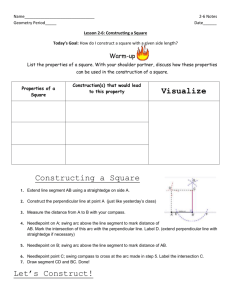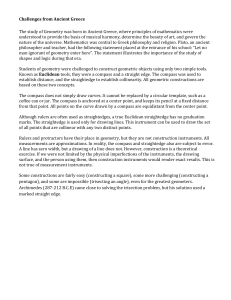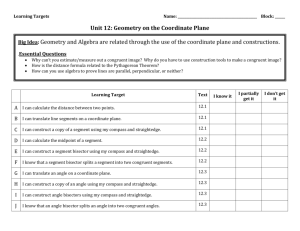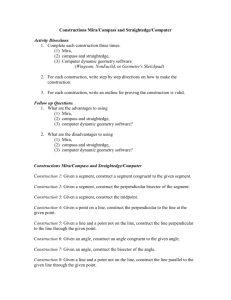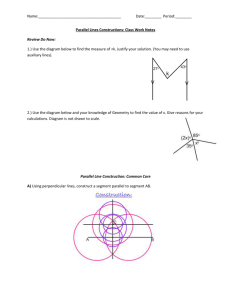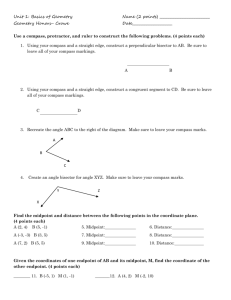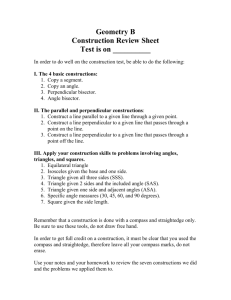Geometry Book-Chapter 2.2
advertisement
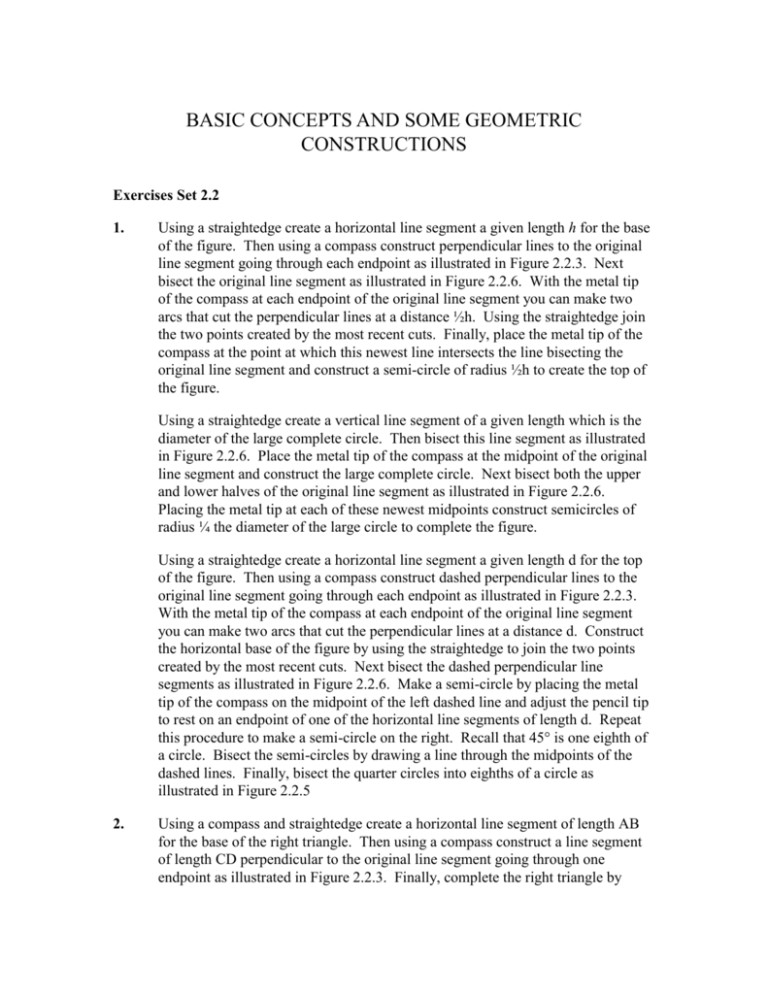
BASIC CONCEPTS AND SOME GEOMETRIC CONSTRUCTIONS Exercises Set 2.2 1. Using a straightedge create a horizontal line segment a given length h for the base of the figure. Then using a compass construct perpendicular lines to the original line segment going through each endpoint as illustrated in Figure 2.2.3. Next bisect the original line segment as illustrated in Figure 2.2.6. With the metal tip of the compass at each endpoint of the original line segment you can make two arcs that cut the perpendicular lines at a distance ½h. Using the straightedge join the two points created by the most recent cuts. Finally, place the metal tip of the compass at the point at which this newest line intersects the line bisecting the original line segment and construct a semi-circle of radius ½h to create the top of the figure. Using a straightedge create a vertical line segment of a given length which is the diameter of the large complete circle. Then bisect this line segment as illustrated in Figure 2.2.6. Place the metal tip of the compass at the midpoint of the original line segment and construct the large complete circle. Next bisect both the upper and lower halves of the original line segment as illustrated in Figure 2.2.6. Placing the metal tip at each of these newest midpoints construct semicircles of radius ¼ the diameter of the large circle to complete the figure. Using a straightedge create a horizontal line segment a given length d for the top of the figure. Then using a compass construct dashed perpendicular lines to the original line segment going through each endpoint as illustrated in Figure 2.2.3. With the metal tip of the compass at each endpoint of the original line segment you can make two arcs that cut the perpendicular lines at a distance d. Construct the horizontal base of the figure by using the straightedge to join the two points created by the most recent cuts. Next bisect the dashed perpendicular line segments as illustrated in Figure 2.2.6. Make a semi-circle by placing the metal tip of the compass on the midpoint of the left dashed line and adjust the pencil tip to rest on an endpoint of one of the horizontal line segments of length d. Repeat this procedure to make a semi-circle on the right. Recall that 45° is one eighth of a circle. Bisect the semi-circles by drawing a line through the midpoints of the dashed lines. Finally, bisect the quarter circles into eighths of a circle as illustrated in Figure 2.2.5 2. Using a compass and straightedge create a horizontal line segment of length AB for the base of the right triangle. Then using a compass construct a line segment of length CD perpendicular to the original line segment going through one endpoint as illustrated in Figure 2.2.3. Finally, complete the right triangle by using the straightedge to connect the unused endpoints of the two given perpendicular sides. 3. Using a compass and straightedge create a horizontal line segment of length EF for the base of the right triangle. Then at one endpoint construct an angle congruent to <M. Next using a compass construct a perpendicular line segment to the original line segment going through the other unused endpoint as illustrated in Figure 2.2.3. Finally, complete the right triangle by extending the last two lines until they intersect one another. 4. Using a compass and straightedge create a horizontal line segment of length AB for the base of the triangle. Then at each endpoint intersect this original line segment with additional line segments of lengths CD and EF using a compass such that the two circles with radii CD and EF intersect one another completing the triangle. 5. Using a compass and straightedge create a horizontal line segment of length AB for the base of the triangle. Then at one endpoint intersect this original line segment with another line segment of length CD (using a compass with radius CD). Finally, complete the triangle by constructing an angle congruent to angle <M with vertex at the unused endpoints of the two given line sides. 6. Using a compass and straightedge create a horizontal line segment of length EF for the base of the triangle. Then at one endpoint construct an angle congruent to <M and at the other endpoint construct an angle congruent to <N. intersect. Complete the triangle by extending the last two lines until they intersect one another. 7. Using a compass and straightedge create a horizontal line segment of given length AB for the length of the rectangle. Then using compass construct perpendicular lines to the original line segment going through each endpoint as illustrated in Figure 2.2.3. With the metal tip of the compass at each endpoint of the original line segment you can make two arcs that cut the perpendicular lines at the given length of CD. Finally, construct the other horizontal side of the rectangle by using the straightedge to join the two points created by the most recent cuts. 8. Line l and point A out of line l are given. Pass a transversal from A to cut line l at point B. Place the metal tip of the compass at point B and cut an arc through line l and the transversal as shown in Figure 2.2.11. On the transversal, using point A, without adjusting the compass place the metal tip at point A and cut an arc through the transversal at the location of the corresponding angle. Using the tips of the compass measure the length of the arc cut at point B. Without adjusting the compass mark this same length on the arc cut at point A. Using the straight edge draw a line passing through point A and the mark showing the length of the arc. The resulting line is parallel to the given line l. 9. Line l and point A out of line l are given. Pass a transversal from A to cut line l at point B. Place the metal tip of the compass at point B and cut an arc through line l and the transversal as shown in Figure 2.2.12. On the transversal, using point A, without adjusting the compass place the metal tip at point A and cut an arc through the transversal at the location of the alternate interior angle. Using the tips of the compass measure the length of the arc cut at point B. Without adjusting the compass mark this same length on the arc cut at point A. Using the straight edge draw a line passing through point A and the mark showing the length of the arc. The resulting line is parallel to the given line l.
